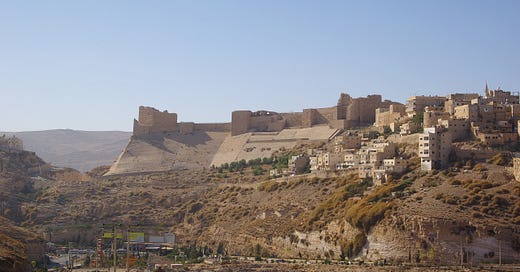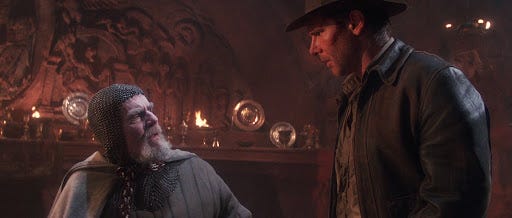Five Books on the Crusades
A look back at a defining example of the human capacity for folly on a grand scale

When we consider the long and storied annals of human folly, few episodes loom larger than or command as much attention as the Crusades. It’s an endlessly and morbidly fascinating subject, dramatic and desperate and delusional all at once—one that illustrates the seemingly endless human capacity to take ideals and beliefs as inspiration for violence and brutality. While the centuries-long struggle between Christians and Muslims for control of the Holy Land understandably remains at the forefront of popular memory of the Crusades, it’s also important to remember that these religious wars stretched from Spain to the Baltic and were directed against heretical Christian sects and pagans as well.
As we embark upon our own march of folly in the present day, it’s worth taking a look back at one of this defining example from the past with these five books:
The Crusades: The Authoritative History of the War for the Holy Land: If you only read one book about the Crusades, make it historian Thomas Asbridge’s 2011 single-volume history. Asbridge’s account is probably the most accessible one available, from the first call to Crusade at Clermont in 1095 and the bloody siege of Jerusalem four years later to the final fall of Acre in 1291 and the ultimate historical legacy of the conflicts. Against modern politicians and activists who appropriate the Crusades for their own purposes, moreover, Asbridge rightly concludes that “the crusades must also be placed where they belong: in the past.”
The World of the Crusades: An Illustrated History: This lavishly illustrated book by Christopher Tyerman, perhaps the premiere modern historian of the Crusades, more than lives up to its title and gives readers a glimpse of the world that produced and was created by the Crusades. Castles, tapestries, and psalters, among other material remnants, fill these pages alongside capsule biographies of figures like the militant monk Bernard of Clairvaux and the historian William of Tyre. The Crusades matter, Tyerman sums up, “as prominent features of half a millennium of European and Mediterranean history, as witnesses to the present’s complex and conflicted relationship with the past, and as testimony to the challenges and contradictions of the human experience.” Other books by Tyerman worth checking out include How to Plan a Crusade: Religious War in the High Middle Ages and the doorstopper God’s War: A New History of the Crusades.
The Siege of Acre: Saladin, Richard the Lionheart, and the Battle That Decided the Third Crusade: Military historian John D. Hosler’s slim account of the year-and-a-half long siege of Acre by the Third Crusade—a battle that involved English King Richard I, French King Philip II, and other Christian notables as well as the legendary Muslim warlord Saladin—from 1189 to 1191 lays bare the squalid nature of medieval warfare. Rampant disease and starvation did as much to determine the course of the siege as battle tactics and weaponry; in the end, though, Crusader tenacity and Saladin’s strategic errors led to the fall of the city and the re-establishment of a Crusader foothold in the Holy Land for another century.
The Templars: The Rise and Spectacular Fall of God's Holy Warriors: This popular account by British historian and presenter Dan Jones makes clear that the real history of the Knights Templar—the military order founded in the wake of the First Crusade to protect pilgrims traveling to and in the Christian kingdoms established in the Holy Land—is far more enthralling than the fictions and conspiracies they’ve generated over the centuries. More than just an elite warrior caste, the Templars built a network of castles across the Levant and established an international banking network before they were condemned as heretics and their property seized in a power grab by the French monarchy. Jones subsequently authored a book on the Crusades themselves, the aptly-titled Crusaders, and his big-picture history of the Middle Ages, Power and Thrones, touches on the subject as well.
The Accursed Tower: The Fall of Acre and the End of the Crusades: The last major outpost of the Crusader kingdoms by the late thirteenth century, the city of Acre fell to Mamluk forces in 1291 and effectively closed the main chapter of the Crusades. Historian Roger Crowley—author of a number of tales of Mediterranean history—brings the tale of this fateful siege to life, describing in vivid terms ill-fated Crusader efforts to hold Acre against a ruthless and fanatical enemy. It’s a riveting narrative of interest to anyone fascinated with doomed last stands as well as the ultimate demise of the Crusades.
Other books worth reading on the Crusades include Queens of Jerusalem: The Women Who Dared to Rule, a history of the female monarchs and political leaders of the Crusader kingdoms by Katherine Panagonis, and the Penguin Monarchs biography of Richard I by Thomas Asbridge.
He Chose… Poorly
The Crusades have exerted their fair share of influence over Western popular culture in the centuries since the demise of the Crusader kingdoms of the Levant, from the earliest Robin Hood and Holy Grail legends through nineteenth century literature like Sir William Scott’s Ivanhoe and The Talisman to modern nonsense about the Templars that undergirds Dan Brown’s The Da Vinci Code and the Assassin’s Creed video game series.
But there’s only one crusade that really matters: Indiana Jones and the Last Crusade, the best of the Indiana Jones film series and a powerful meditation on morality, mortality, and family wrapped up in an action-adventure package.



